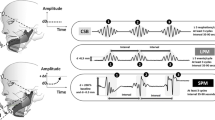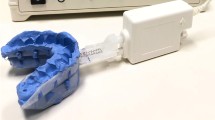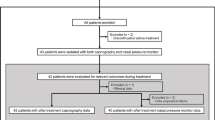Abstract
Perioperative complications related to obstructive sleep apnea still occur despite the use of partial pressure end-tidal CO2\(\left( {{{\text{P}}_{{\text{ETC}}{{\text{O}}_2}}}} \right)\) and pulse oximetry. Airway obstruction can complicate propofol sedation and a novel monitor combining mandibular movement analysis with capnography may facilitate its detection. Patients scheduled for sleep endoscopy were recruited and monitored with standard monitoring, \({{\text{P}}_{{\text{ETC}}{{\text{O}}_2}}},\) and Jaw Activity (JAWAC) mandibular movement sensors. A post hoc analysis investigated airway obstruction prediction using a Respiratory Effort Sequential Detection Algorithm (RESDA) based on \({{\text{P}}_{{\text{ETC}}{{\text{O}}_2}}}\) and mandibular movement signals. 21 patients were recruited and 54 episodes of airway obstruction occurred. RESDA detected obstructive apnea [mean ± SD (median)] 29 ± 29 (21) s, p < 0.0001, before \({{\text{P}}_{{\text{ETC}}{{\text{O}}_2}}}\) alone. This prolonged the time between obstructive apnea detection and decrease to 90% oxygen saturation 64 ± 38 (54) versus 38 ± 20 (35) s, p < 0.0001. It predicted airway obstruction with a sensitivity and specificity of 81% and 93%, respectively. The RESDA algorithm, which is based on the combination of capnography with mandibular movement assessment of respiratory effort, can more rapidly alarm anesthetists of airway obstruction during propofol sedation than \({{\text{P}}_{{\text{ETC}}{{\text{O}}_2}}}\) alone. However, \({{\text{P}}_{{\text{ETC}}{{\text{O}}_2}}},\) pulse oximetry, and clinical monitoring are still required.
Trial Registry numbers: ClinicalTrial.gov (NCT02909309) https://clinicaltrials.gov/ct2/show/NCT02909309.


Similar content being viewed by others
References
Metzner J, Posner KL, Domino KB. The risk and safety of anesthesia at remote locations: the US closed claims analysis. Curr Opin Anaesthesiol. 2009;22(4):502–8.
Coté GA, Hovis RM, Ansstas MA, et al. Incidence of sedation-related complications with propofol use during advanced endoscopic procedures. Clin Gastroenterol Hepatol. 2010;8:137–42.
New Standards Monitoring. Association of Anaesthetists of Great Britain and Ireland. 2016. https://www.aagbi.org/news/new-standards-monitoring-which-mandate-capnography-during-anaesthesia-recovery-and-sedation-aim. Accessed 1 May 2018.
Practice Guidelines for Moderate Procedural Sedation and Analgesia 2018 A Report by the American Society of Anesthesiologists Task Force on Moderate Procedural Sedation and Analgesia, the American Association of Oral and Maxillofacial Surgeons. American College of Radiology, American Dental Association, American Society of Dentist Anesthesiologists, and Society of Interventional Radiology. Anesthesiology. 2018;128(3):437–79.
Hinkelbein J, Lamperti M, Akeson J, et al. European Society of Anaesthesiology and European Board of Anaesthesiology guidelines for procedural sedation and analgesia in adults. Eur J Anaesthesiol. 2018;35(1):6–24.
Martinot JB, Le-Dong N, Cuthbert V, et al. Mandibular movements as accurate reporters of respiratory effort during sleep: validation against diaphragmatic electromyography. Front Neurol. 2017;8:353.
Cattrysse F, Peeters M, Calaerts S, Ferson K, Degryse JM. Detection of sleep apnea by case-finding and home monitoring with Somnolter a pilot study. BMC Res Notes Sep. 2014;7:616.
Marsh B, White M, Morton N, Kenny GN. Pharmacokinetic model driven infusion of propofol in children. Br J Anaesth. 1991;67:41–8.
Traxdorf M, Tschaikowsky K, Scherl C, et al. Drug-induced sleep endoscopy (DISE) with target controlled infusion (TCI) and bispectral analysis in obstructive sleep apnea. J Vis Exp. 2016. https://doi.org/10.3791/54739.
Landis JR, Koch GG. An application of hierarchical kappa-type statistics in the assessment of majority agreement among multiple observers. Biometrics. 1977;33(2):363–74.
Niesters M, Mahajan RP, Aarts L, Dahan A. High-inspired oxygen concentration further impairs opioid-induced respiratory depression. Br J Anaesth. 2013;110(5):837–41.
Vincent JL, Einav S, Pearse R, et al. Improving detection of patient deterioration in the general hospital ward environment. Eur J Anaesthesiol. 2018;35(5):325–33.
Applegate R, Lenart J, Malkin M. Meineke M. Qoshlli S, et al. Advanced monitoring is associated with fewer alarm events during planned moderate procedure-related sedation: a 2-part pilot trial. Anesth Analg. 2016;122(4):1070–8.
Maury G, Senny F, Cambron L, Albert A, Seidel L, Poirrier R. Mandible behaviour interpretation during wakefulness, sleep and sleep-disordered breathing. J Sleep Res. 2014;23:709–16.
Cavalcante A, Martin Y, Sprung J, Imsirovic J, Weingarten T. Low minute ventilation episodes during anesthesia recovery following intraperitoneal surgery as detected by a non-invasive respiratory volume monitor. J Clin Monit Comput. 2017;32(5):909–935.
Faßbender P, Haddad A, Bürgener S, Peters J. Validation of a photoplethysmography device for detection of obstructive sleep apnea in the perioperative setting. J Clin Monit Comput. 2018. https://doi.org/10.1007/s10877-018-0151-2.
Acknowledgements
The authors would like to thank Vincent Jame for his help, the medical teams of the Erasme Hospital for providing the highest possible quality of care to all patients, and Nomics for providing the monitor and developing the software for this study.
Author information
Authors and Affiliations
Contributions
NP: study design, patient recruitment, acquisition of data, data analysis, initial draft writing and approval of manuscript. SC: data analysis, interpretation of data, initial draft, and approval of manuscript. EE: data analysis, interpretation of data, critical revision of draft and approval of manuscript. TT: study design, critical revision of draft, and approval of manuscript. LVO: study design, critical revision of draft, and approval of manuscript. LB: study design, critical revision of draft, and approval of manuscript. All authors agree to be accountable for all aspects of their work and ensure that questions related to the accuracy or integrity of any part of the work are appropriately investigated and resolved.
Corresponding author
Ethics declarations
Conflict of interest
The authors declares that they have no conflict of interest.
Rights and permissions
About this article
Cite this article
Ponthieu, N., Coeckelenbergh, S., Engelman, E. et al. Synchronized mandibular movement and capnography: a novel approach to obstructive airway detection during procedural sedation—a post hoc analysis of a prospective study. J Clin Monit Comput 33, 1065–1070 (2019). https://doi.org/10.1007/s10877-018-00250-3
Received:
Accepted:
Published:
Issue Date:
DOI: https://doi.org/10.1007/s10877-018-00250-3




